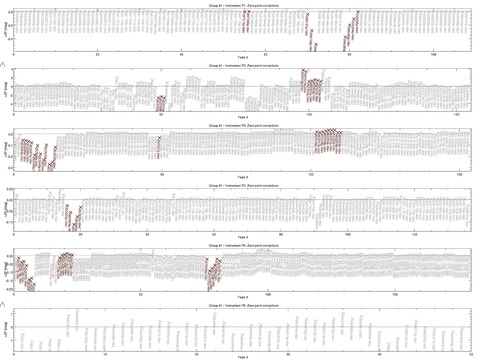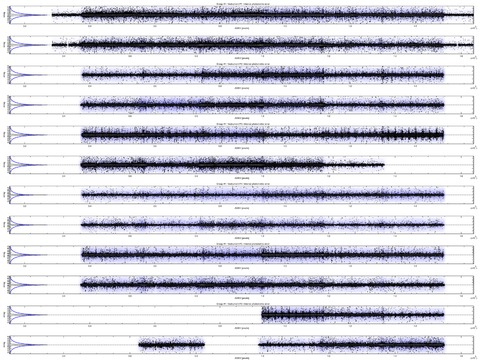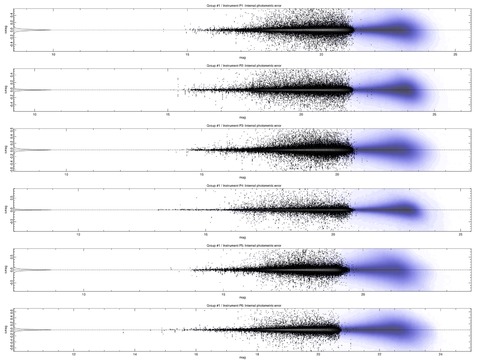 
|
The T0007 astrometric solutions and the initial photometric calibration were computed using Scamp in version 1.7.0. The configuration files which were used are presented in Appendix A.3.1. Scamp is a software developped by Emmanuel Bertin and available on Astromatic14 .
Scamp first reads all image headers and then splits the exposures into a series of astrometric “contexts”. Each context isolates blocks of observing epochs where the instrument focal plane is in a fixed and (mostly) stable position; for the CFHTLS these contexts can be selected using the CFHT QRUNID FITS header keyword. Special care is taken to correctly flag saturated objects in particular for images for which saturation levels change significantly across the mosaic (described in Section 3.4).
An approximate first-guess for the position of astrometric sources is derived by the cross-identification of sources in the QFITS-in .ldac catalogues with the 2MASS external reference catalogue (?). As in previous releases, 2MASS was chosen because astrometric solutions were stable and more accurate than using the USNO. (We note that ultimately an SDSS-based calibration would have been preferable because of the higher surface density of sources in SDSS and the similarity of SDSS and CFHTLS filter sets; however the SDSS does not cover the whole CFHTLS survey; only W3 and D2 and D3 fields have complete coverage.)
To match CFHTLS and 2MASS catalogues we choose a source matching radius (CROSSID_RADIUS) of 2.0 arcsec for all Wide and Deep fields. A 3rd order polynomial distortion model is then derived by minimizing a weighted quadratic sum of differences in positions between the 2MASS and the QFITS-in matched sources, and, internally, between different QFITS-in catalogues with overlapping regions of MegaCam images (see Fig. 21). Scamp then computes the astrometric internal errors from the differences of astrometric positions of sources inside the overlapping regions and the external errors from the comparisons of astrometric positions of MegaCam sources with the 2MASS catalogue.
Images are calibrated separately for each of the four Wide and four Deep fields. However, in order to take full advantage of L99 photometric images, processing is done in two steps:
In addition, due to the large number of exposures in some of the fields the astrometric calibrations cannot be solved globally (due to memory requirements) and are additionally split by filter. For those fields the large number of observing runs produces too many astrometric contexts which cannot be handled by Scamp using current Terapix computing resources. For this reason, the astrometric calibration is computed in a field-dependent way.
For the W1 field, for which the astrometric solution is derived with respect to a reference catalogue we use this procedure:
For W2, W3 and W4 fields, the astrometric solution is calculated once for each field by considering all selected images simultaneously, regardless the filter, exposure type or epoch, using 2MASS. In this way all images of a given Wide field are calibrated globally and in a homogeneous way.
All Deep fields are calibrated with scamp in a similar way as W1. However, the image selection used to construct the internal reference catalogue is done differently:
The astrometric solution for the Deep fields is derived using the same recipe for each field, thus improving the consistency of the calibrations between the four Deep fields.
Astrometric solutions have been verified by examining the large range of check-plots produced by Scamp, in particular the 1D and 2D internal and external astrometric solutions as a function of RA and DEC, the reduced chi-squared for the astrometric solution, and the field-to-field photometric offset. After an optimal solution is calculated, this astrometric solution is written in a separate .head file for each input image.
In T0007, the initial photometric field-to-field rescaling is computed separately from the astrometric solution. Photometric flags are written in the .ahead files together with the default zero point provided by CFHT and derived from the astrometric solution computed in the previous step. As for the astrometric calibration, Scamp minimizes the quadratic sum of magnitudes using the overlapping regions between images. It then re-scales the flux of non photometric images accordingly (Fig. 5 and Fig. 6). After this step a “final” photometric rescaling is computed for each of the image tiles; this is described in detail in Section 3.7.
 
|

|
Finally, these astrometric and photometric solutions are combined into a single output .head file for each image (containing information for all of the 36 MegaCam extensions) which is then used for producing the Wide and Deep stacks using SWarp. All Scamp output data including .xml tables, diagnostic plots, .ahead and .head files can be found in the T0007 synoptic table.